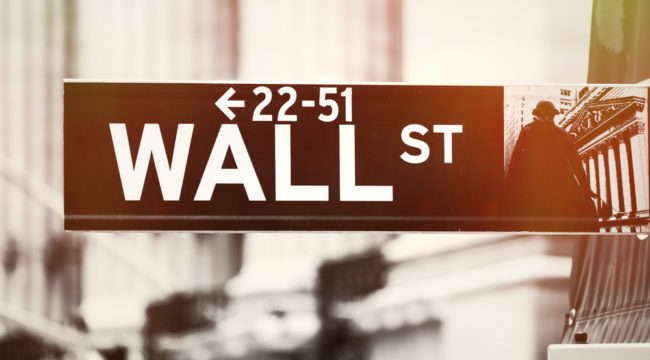“Bad News Is Good News” Is Back
Today we present two warring narratives.
Combined they tell the tale of the past decade — one of Main Street, one of Wall Street.
First to Main Street… and a sample of yesterday’s headlines:
“U.S. Existing Home Sales Fall Sharply to Three-Year Low”…
“U.S. Business Spending on Equipment Weakening”…
“Business Spending Suffers Longest Contraction Since 2015”…
“U.S. Core Capital Goods Orders Unexpectedly Fall in December”…
“Weak U.S. Data Underscore Growing Head Winds to Economy”…
“As Trump Economy Slows, New Data Show Lagging Business Confidence”…
“J.P. Morgan Cuts U.S. First-Quarter GDP Growth View to 1.5%.”
Please reconcile the preceding with the following headlines, dated Feb. 20 or 21:
“The Dow Jones Industrial Average, at the Current Pace, Is on Track to Hit 30,000 in April”…
“’Panic Buying’ Likely to Drive Stock Market Higher in the Near Term”…
“Stock Market Breadth Is More Bullish Than the Dow, S&P 500 Gains Suggest”…
“This Stock Market Gauge Just Hit an All-Time High — and That’s Bad News for Bears”…
“Dow Rises as Fed Says Growth Risks Cause Pause in Rate Hikes”…
“Stock Market Shrugs off Fed Minutes in Another Good Day for the Bulls.”
Those Fed minutes were released Wednesday.
They reveal one cardinal fact:
The Federal Reserve recognizes its December hawkishness multiplied the rout then in progress.
Explains CNBC:
Participants noted market belief that the balance sheet reduction helped cause the late-2018 market volatility, and noted that investors interpreted communications from the December meeting as “not fully appreciating the tightening of financial conditions and the associated downside risks to the U.S. economic outlook that had emerged since the fall.”
In working English:
The Federal Reserve admits the stock market has it hostage… and holds a pistol to its head.
Should he hazard an escape, Jerome Powell realizes it will yank the trigger.
Peter Boockvar, chief investment officer at Bleakley Advisory Group:
“Bottom line… it should be clear to everyone that they [the Fed] are mostly beholden to asset prices…”
It is certainly clear to us.
The run of headlines above cements the deeper point:
“Bad news is good news” has returned.
That is, bad news for Main Street is good news for Wall Street.
Bad news for Main Street means the Federal Reserve lifts its foot from the monetary brake pedal.
The light turns green for the stock market — while the real economy is stuck on red.
It was a pattern established well under the reign of “Helicopter Ben” Bernanke.
The economy would sputter and smoke. Mr. Bernanke would then sit on the gasoline pedal.
The resulting liquidity would flood through Wall Street… and lift the stock market to gorgeous new heights.
But the fuel lines bypassed Main Street altogether… as they bypass Main Street today.
The two diametric sets of headlines above provide all required documentation.
But the Federal Reserve may not be solely responsible for the latest upswing…
M2 money supply for the world’s 12 major economies — including the United States, China, Japan and Europe — tracks reasonably with the post-Christmas stock surge.
M2 peaked last April at $73.1 trillion. It subsequently declined before bottoming at $69.8 trillion by mid-November.
The severe 19.5% market correction — incidentally — began roughly one month prior.
But by the close of January, the money supply rebounded nearly $3 trillion… to $72.6 trillion.
The S&P subsequently leapt out to its fastest yearly start in nearly a decade — up some 12%
Is this the work of coincidence?
It is possible… we suppose.
Meantime, the fools continue rushing in…
Bloomberg informs us the number of advancing stocks on the NYSE exceeds the number of declining stocks by record amounts.
Analyst David Rosenberg for perspective:
Let’s go back to December for a minute. This was the worst December since 1931, mind you, followed by the best January since 1987. This is nothing more than [a] market that has gone completely manic.
To suggest that there is anything fundamental about this dead-cat bounce in equities is laughable.
“Panic buying” is underway, affirms Masanari Takada, cross-asset strategist at Nomura — the fear of missing out.
But the bullish advance may have overextended its supply lines…
Bloomberg further informs us that most asset classes are presently overbought — for the first occasion since 2000.
But what rises rapidly… often falls rapidly.
Explains analyst Avi Gilburt:
The U.S. stock market has rallied from the December lows in what is an almost straight line higher. Those types of moves do not often end well.
We hazard this one will not end well either.
Regardless, the Federal Reserve cannot keep the show going indefinitely.
And one day, soon or late, Main Street will finally come to Wall Street…
Regards,
Brian Maher
Managing editor, The Daily Reckoning



Comments: